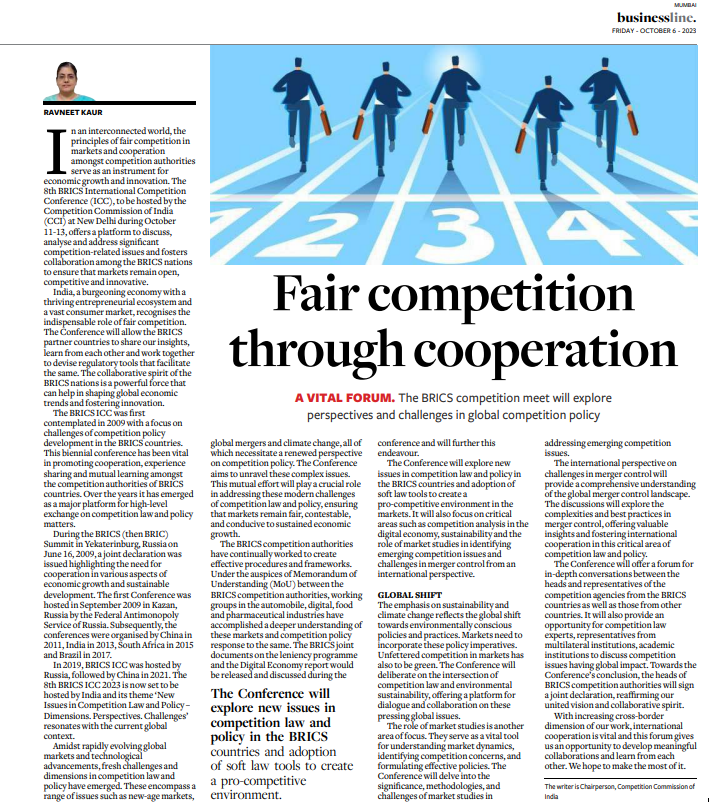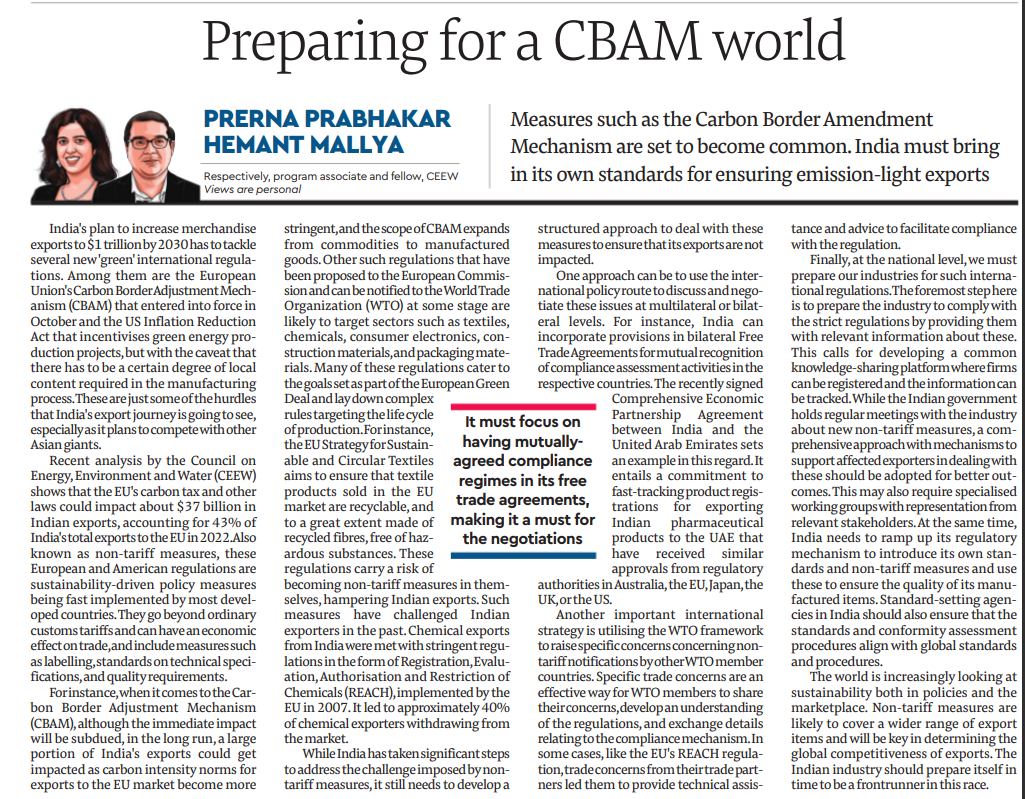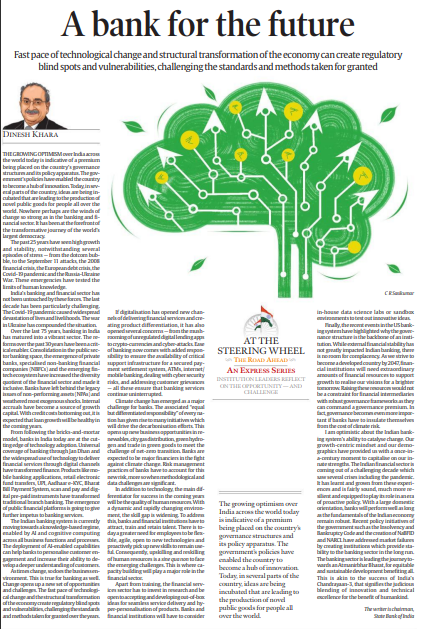THE 8TH BRICS INTERNATIONAL COMPETITION CONFERENCE: FOSTERING ECONOMIC GROWTH AND INNOVATION THROUGH FAIR COMPETITION
Introduction:
The 8th BRICS International Competition Conference (ICC), to be hosted by the Competition Commission of India (CCI), aims to promote economic growth and innovation through the principles of fair competition and cooperation among competition authorities.
This biennial event brings together the BRICS nations (Brazil, Russia, India, China, and South Africa) to discuss and address significant competition-related issues and foster collaboration.
The Role of Fair Competition in India:
- India, with its thriving entrepreneurial ecosystem and vast consumer market, recognizes the importance of fair competition.
- The conference provides a platform for BRICS countries to share insights, learn from each other, and devise regulatory tools to facilitate fair competition, which is essential for economic growth.
The Evolution of BRICS ICC:
- The BRICS ICC was first proposed in 2009 during a joint declaration highlighting the need for cooperation in various aspects of economic growth and sustainable development.
- Since then, the conference has played a crucial role in promoting cooperation, experience sharing, and mutual learning among BRICS competition authorities. It has become a major platform for high-level exchange on competition law and policy matters.
Themes of the 8th BRICS ICC 2023:
The 8th BRICS ICC, with the theme “New Issues in Competition Law and Policy – Dimensions. Perspectives. Challenges,” addresses the evolving global context. It focuses on modern challenges, including new-age markets, global mergers, climate change, and more, necessitating a renewed perspective on competition policy.
Collaborative Efforts and Frameworks:
- BRICS competition authorities have been working together to create effective procedures and frameworks.
- Memorandums of Understanding (MoUs) have enabled working groups in various industries to gain a deeper understanding of these markets and competition policy responses.
- Joint documents on the leniency program and the Digital Economy report will be released and discussed during the conference.
Key Discussion Areas:
- The conference will explore new issues in competition law and policy, emphasizing the adoption of soft law tools to create a pro-competitive market environment.
- It will also delve into critical areas such as competition analysis in the digital economy, sustainability, the role of market studies in identifying emerging competition issues, and challenges in merger control from an international perspective.
Global Shift towards Sustainability:
- The emphasis on sustainability and climate change aligns with the global shift toward environmentally conscious policies and practices.
- The conference will discuss the intersection of competition law and environmental sustainability, offering a platform for dialogue and collaboration on these pressing global issues.
Importance of Market Studies:
- Market studies are crucial for understanding market dynamics, identifying competition concerns, and formulating effective policies.
- The conference will delve into the significance, methodologies, and challenges of market studies in addressing emerging competition issues.
International Cooperation in Merger Control:
- Discussions on challenges in merger control will provide a comprehensive understanding of the global merger control landscape.
- It will explore complexities and best practices, fostering international cooperation in this critical area of competition law and policy.
A Platform for In-Depth Conversations:
- The conference offers a forum for in-depth conversations between heads and representatives of BRICS competition agencies, as well as representatives from other countries, multilateral institutions, and academic institutions.
- A joint declaration at the conclusion of the conference reaffirms the collaborative spirit and united vision of BRICS competition authorities.
Conclusion:
In an interconnected world, the 8th BRICS International Competition Conference serves as a platform for BRICS nations to collaborate and address modern competition-related challenges.
By promoting fair competition and cooperation, this conference plays a vital role in shaping global economic trends and fostering innovation.
THE 8TH BRICS INTERNATIONAL COMPETITION CONFERENCE: FOSTERING ECONOMIC GROWTH AND INNOVATION THROUGH FAIR COMPETITION
Introduction:
India aims to boost merchandise exports to $1 trillion by 2030, but it faces significant challenges due to new green international regulations.
These regulations include the European Union’s Carbon Border Adjustment Mechanism (CBAM) and the US Inflation Reduction Act, which promote sustainability and green energy production.
These non-tariff measures go beyond traditional customs tariffs and can have a significant impact on trade.
The Impact of EU and US Regulations:
- A recent analysis by the Council on Energy, Environment, and Water (CEEW) estimates that the EU’s carbon tax and related laws could affect approximately $37 billion in Indian exports, accounting for 43% of India’s total exports to the EU in 2022.
- These regulations encompass various sectors, including textiles, chemicals, consumer electronics, construction materials, and packaging materials, aiming to ensure sustainability and circularity in production.
- While the immediate impact may be limited, as carbon intensity norms become stricter and CBAM expands its scope, Indian exports could face more significant challenges.
Historical Precedents:
Indian exporters have previously encountered stringent regulations, such as the EU’s Registration, Evaluation, Authorisation and Restriction of Chemicals (REACH) in 2007, which led to a substantial withdrawal of chemical exporters from the EU market. These past experiences underscore the importance of addressing non-tariff measures effectively.
Strategies to Mitigate Impact:
- International Negotiations: India can use bilateral Free Trade Agreements to negotiate provisions for mutual recognition of compliance assessment activities. For example, the India-UAE Comprehensive Economic Partnership Agreement facilitates fast-tracking product registrations for Indian pharmaceutical products with approvals from specific regulatory authorities.
- WTO Framework: Utilizing the World Trade Organization (WTO) framework, India can raise specific concerns regarding non-tariff notifications by other member countries. Specific trade concerns can lead to a better understanding of regulations and technical assistance to facilitate compliance, as seen with the EU’s REACH regulation.
- National Preparedness: India should prepare its industries for international regulations by providing relevant information and establishing a knowledge-sharing platform for firms. Comprehensive mechanisms, including specialized working groups with industry representation, can support affected exporters in compliance efforts. Additionally, India needs to enhance its regulatory framework to introduce its own standards and non-tariff measures aligned with global standards.
Conclusion:
In a world increasingly focused on sustainability, non-tariff measures play a pivotal role in determining global export competitiveness. India must prepare its industries to navigate these challenges effectively to maintain and enhance its position in the international marketplace. This entails international negotiations, engagement with the WTO, and robust national strategies for compliance and standards alignment.
India's Banking and Financial Sector: Transformations, Challenges, and the Path Forward
Introduction:
The global optimism surrounding India today reflects the recognition of its robust governance structures and policy apparatus. The country’s innovative prowess, particularly in the banking and financial sector, has made it a crucible of change over the last 25 years.
Growth and Stability Amid Challenges:
- Despite significant global upheavals, including the dotcom bubble, 9/11 attacks, 2008 financial crisis, European debt crisis, Covid-19 pandemic, and Russia-Ukraine War, India’s banking and financial sector has demonstrated high growth and resilience. Over the past decade, it has faced formidable challenges, particularly from the Covid-19 pandemic and Ukraine conflict.
Evolution of the Banking Sector:
- India’s banking sector has evolved significantly in the last 75 years, with critical reforms over the past three decades fostering growth and inclusivity.
- The sector has diversified through public sector banking consolidation, emergence of private banks, specialized non-banking financial companies (NBFCs), and a burgeoning fintech ecosystem.
- It has successfully tackled legacy issues like non-performing assets (NPAs) and adapted to exogenous shocks.
Technological Advancements:
- The sector has transitioned from a bricks-and-mortar model to embrace cutting-edge technology.
- Initiatives like Jan Dhan and digital channels have revolutionized financial services. Products like mobile banking apps, UPI, Aadhaar e-KYC, and digital pre-paid instruments have transformed traditional banking.
- The integration of AI and cognitive computing is poised to further personalize customer engagement and deepen understanding.
Challenges of Digitalization:
- While digitalization presents opportunities, it also poses concerns, from unregulated digital lending apps to cryptocurrencies and cyber threats.
- Banks must ensure the availability of robust support infrastructure to safeguard payment systems, ATMs, internet/mobile banking, and address cybersecurity risks.
Climate Change Imperative:
- Banks are confronted with the challenge of climate change. The global responsibility for decarbonization creates opportunities in renewables, green hydrogen, and green trade.
- Banks are expected to play a major role in financing this transition while managing associated risks.
Human Resources and Skill Gap:
- As the environment rapidly changes, the skill gap widens. Banks must attract, train, and retain adaptable, tech-savvy talent.
- Upskilling and reskilling are essential to meet emerging challenges.
- Capacity building, research, and innovative thinking will play pivotal roles in the sector’s success.
Governance and Financial Stability:
- Recent events in the US banking system underscore the importance of robust governance.
- Strong governance frameworks enable financial intermediaries to command a governance premium, facilitating resource mobilization.
- Governance becomes critical in mitigating climate risks and supporting India’s journey to becoming a developed country by 2047.
Conclusion:
India’s banking and financial sector has emerged from a challenging decade stronger and more resilient. With a growth-centric mindset and demographic advantage, it is poised to play a pivotal role in India’s journey towards equitable and sustainable development.
Policy initiatives like the Insolvency and Bankruptcy Code and the creation of institutions like NaBFID and NARCL provide stability and pave the way for an Atmanirbhar Bharat. This sector’s success mirrors India’s spirit of innovation and excellence for the benefit of humanity, akin to the success of Chandrayaan-3.





